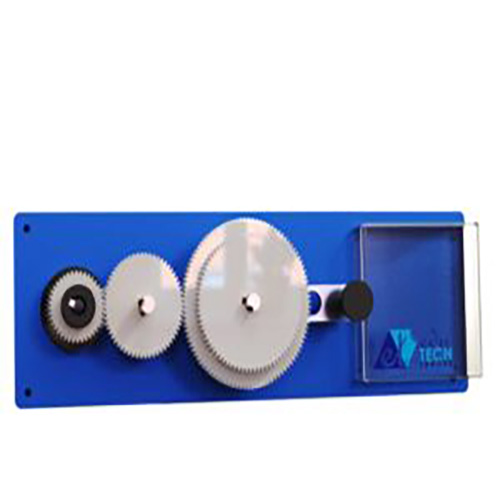EM-211 | Gear Train Apparatus
- Investigation of single-stage or multistage spur gears
- Investigation of planetary gears
- Driven by hand
- Determine the transmission ratio by counting the revolutions of the driven gears
- Base plate
- LxWxH: 380x120x100mm
- Weight: approx. 3kg
Description
Technical Specification
Media
The gear is the element of a machine that transmits and transforms motion. A gear comprises at least one drive, an output and a frame. Gear drives are uniform translation gears. The rotary motion is transferred from one shaft to a second through positive transmission by gears. In spur gears, the gears are mounted on parallel axles. The drive and the output shaft are arranged in parallel. Planetary gears are a type of spur gears, in which the drive and the output shafts are on the same axle.
This experimental unit can be used to study gear drives in the form of spur or planetary gears. The unit focuses on the consideration of kinematics. The experimental unit consists of a base plate with a fixed axle, on which is mounted a pivoting rail. Two other axles can be attached at any position on this rail. Selecting and combing the gears with different numbers of teeth allows you to realise different transmission ratios and gear types.
The rail is locked in experiments with spur gears. Depending on the aim of the experiment, one or two additional axles can be positioned on the rail. The gears can be coupled to each other via driving pins or to the fixed axle. It is driven by hand. The full revolutions are counted to determine the transmission ratio.
To investigate planetary gears, the rail is released and pivoted about the fixed axle. The rail serves as a planetary wheel support on which the planetary wheels are positioned and represents the input of the gear. The sun wheel forms the output of the gear. It is driven by hand. The transmission ratio can be determined by counting the full revolutions.
- quantity: 4
- plastic
- module: 1mm
- number of teeth: 40, 60, 80 and 100
Any questions? We are happy to help...
+49 40 670 854 - 0
sales@gunt.de
Newsletter
About Us
EduTech Lahore excels in designing and supplying cutting-edge equipment for Engineering Education in Mechanical, Polymer Chemical, Civil and Control Engineering. Focused on meeting the demand for quality education, we offer cost-effective solutions for the latest teaching equipment.
Contact Info
Head Office (Asia)
EduTech
Lahore
Regional Partner Office (UK)
Sales Partner (Middle East) GCC International FZC
Leave a Message
WhatsApp us

